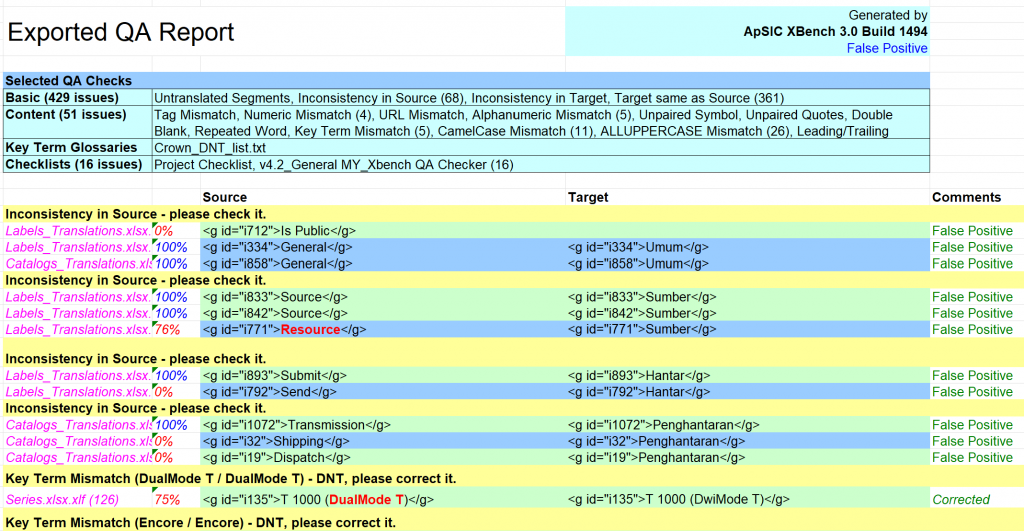In this article we aim to shed light on the importance of QA processes in localization engineering, emphasizing the role of tools like X-Bench and the strategies to manage false positives efficiently. The focus remains on the technical aspects of the QA process while highlighting the expertise required to navigate the challenges presented by automated QA checks.
X-Bench Reports and False Positives in Localization QA Processes
In the meticulous arena of localization and translation, Quality Assurance (QA) stands as a critical phase, ensuring the accuracy, consistency, continuity, and terminology management of translated content. Among the diverse tools leveraged for QA is X-Bench, an integrated reference tool often associated with SDL Trados, which provides a platform for automated QA checks.
Though X-Bench is not exclusively used in the context of SDL Trados CAT Tool used by translators during the translation process. While it is often mentioned in conjunction with SDL Trados due to its widespread use in the translation industry and compatibility with Trados-generated files, X-Bench is a standalone quality assurance (QA) tool that can work with a variety of translation tools and file formats.
Its main function is to provide an extensive platform for automated QA checks, which include terminology consistency, numeric discrepancies, double spaces, and unmatched pairs of punctuation, among others.
X-Bench supports files from different translation environments and software through its ability to import various file formats used in the industry. This means it can be utilized with other Translation Management Systems (TMS) and Computer-Assisted Translation (CAT) tools, not just SDL Trados. The tool is designed to be flexible and integrable with numerous workflows, making it a valuable asset for translators, localization engineers, and QA specialists working across different platforms.
The interpretation of X-Bench reports is not always straightforward. A recurrent challenge is the identification and management of false positives—instances where an alert or error is flagged by the system without an actual issue in the translation.
This article delves into the nuances of X-Bench reports within the localization QAprocess and strategies for handling false positives effectively.
Understanding X-Bench Reports
X-Bench, in the context of SDL Trados and other translation environments, offers an array of QA checks, including terminology consistency, numeric discrepancies, double spaces, and unmatched pairs of punctuation. The tool generates detailed reports that highlight potential errors within the translated content, prompting a review from the localization engineer or QA specialist.
Identifying False Positives
A ‘false positive’ in an X-Bench report is akin to a meticulous inspector who occasionally flags items that comply with standards but appear erroneous due to contextual nuances or specific client requirements. These false alerts can arise from various factors such as acceptable variations in terminology, terms that is kept in English, creative translations that need to deviate from the source for cultural appropriateness, or intentional stylistic choices that X-Bench is not configured to recognize.
The Role of X-Bench in QA Processes
The QA process in translation engineering is a safeguard against inaccuracies and inconsistencies. X-Bench contributes to this process by automating the detection of potential errors, but it is the human expert who discerns the true nature of each flag. The tool serves as an assistant, not a decision-maker.
Strategies for Handling False Positives
Addressing false positives requires a two-pronged approach: tool configuration and linguistic expertise. Initially, localization engineers can configure X-Bench’s settings to align with the project’s glossaries and style guides, reducing the occurrence of false flags. Furthermore, when a potential issue is identified, engineers and translators must examine the context, reference materials, and the client’s preferences to determine whether an X-Bench alert represents a genuine issue or a false positive.
Optimizing X-Bench for Greater Accuracy
To minimize the occurrence of false positives, continuous updates to X-Bench configurations are essential. As projects evolve, so too should the QA tool’s settings, incorporating new terminologies and approved exceptions. This dynamic adjustment requires ongoing communication between the project managers, translators, and QA personnel, ensuring that X-Bench aids rather than hinders the localization process.

QA Expertise Beyond Tools
While tools like X-Bench are indispensable, the role of the localization engineer and QA specialist’s expertise cannot be overstated. Their intimate knowledge of linguistic subtleties, coupled with a deep understanding of the target culture, allows them to filter out false positives effectively. These professionals ensure that the translation not only passes technical scrutiny but also resonates with the intended audience.
In the realm of localization translation engineering, X-Bench stands as a vital component of the QA process, yet it is the human element that determines the success of a project. Understanding and managing false positives is a testament to the expertise of the translation team, balancing the precision of automated tools with the nuance of human judgment. Through meticulous configuration of tools and the seasoned insight of QA professionals, the industry upholds its commitment to delivering translations that are both technically accurate and culturally attuned.




